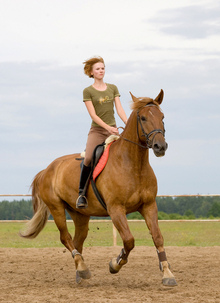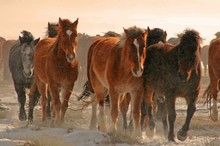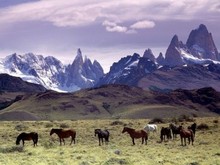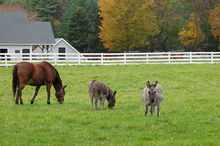Owning a horse is an amazing and rewarding experience and many horse owners wanting to give their horse(s) the best possible life become confused about what that "best possible life" entails for the domesticated horse.

Horse fitness through movement
Since no one method of horse care is the be all or end all when it comes to keeping horses healthy, it is important for horse owners to educate themselves about best practices in horse care and to take cues from other capable horse owners and equine research.
Sadly, the many sources of information and the many products available related to horse care can be misleading and are often based on the marketing of products and services rather than on the realistic needs of the horse. This leaves the average horse owner confused, if not mystified and stymied.
Since no one method of horse care is the be all or end all when it comes to keeping horses healthy both physically and mentally, it is important for horse owners to continually educate themselves about best practices in horse care and to take cues from other capable horse owners and equine research.
Over the years, researchers have thoroughly investigated the evolution of horses and determined that the way horses live in the wild can serve as a guide for caring for domesticated horses.
Unfortunately, today's horse owners are bombarded by photos of lush green pastures, advertisements for artificially produced feed products and a plethora of sleek horse products and service promotions that empty the pocket book often without improving the lives of horses.
"Our life is frittered away by detail...simplify, simplify, simplify. - Henry David Thoreau." This is a message that horse owners can take to heart as they go about the sometimes daunting chores of feeding, watering, exercising, mucking, vaccinating, deworming their horses.
Based on her years of research and educating horse owners, Dr. Juliet M. Getty implores horse owners to "Feed your horse like a horse." This insightful idea can be expanded to "Treat your horse like a horse" in all horse-care endeavors.
As noted in Horse Health Matters: The Horse Owner's Guide to Equine Healthcare, the survival of the horse in modern times results from his ability to live and cooperate with humans while maintaining the essential characteristics that led to his survival. Understanding the domestic horse's "essential characteristics" is key to better horse well being and health.
Based on their hereditary background, horses have three basic needs for a healthy life: a need to move, a need for a variety of forages, and a need for a hierarchical social structure.
Although most horse owners provide their horses with safe stables, calorie dense meals and basic health care, it is usually done according to human convenience and needs, rather than equine needs. Carefully considering the horse's three basic needs is paramount in determining how horses can benefit most in the domesticated state.
The need to move
A wild horse covers many miles a day in search of feed. This movement over both smooth and rough terrain affects the body, legs and hoofs of the horse in important ways.
The basic biology of the horse requires walking and/or running distances in terrain similar to their native habitat on a daily basis and it stands to reason that domesticated horses that are unable to move even a mile during a given day in their domestic environment are susceptible to both physical and psychological issues.

Wild horses on the move
A wild horse covers many miles a day in search of feed. This movement over both smooth and rough terrain affects the body, legs and hoofs of the horse in important ways.
© 2015 by Jana Wilson
With the wild horse on the move and foraging for a variety of different feed, the digestive system became long and complex with a fairly small stomach. Because of this the equine digestive tract has adapted for constant grazing of small amounts all day.
The physical movement of the horse helps the movement of the food through the digestive tract. For optimal health a horse should have an almost constant supply of small amounts of feed to keep his digestive system working properly.
Near constant movement is important psychologically for horses as prey animals. Their ability to flee from a predator is enhanced by free movement and exercise. Anything new or threatening causes the horse's self-preservation instincts to kick in, causing immediate and sometimes explosive reactions.
When a horse feels cornered as when he is being trailered, or when he is confined to a stall most of the day, fear, anxiety and distress can lead to acting out and may progress into exhibition of stereotypies commonly referred to as vices. When a horse gets plenty of exercise either in an open setting or with a capable owner or handler, the fear, anxiety and distress are minimized.
The wide-ranging mobility of a horse in the wild over a variety of terrain is also beneficial in keeping a horse's hoofs in a healthy state. The walking and running over rocky hillsides, through stream beds, and through pasture land tended to keep the hoofs trim and fit and also kept the blood flow adequate for good hoof health since the hoofs and limbs needed to stay flexible given the different surfaces and the topography of the land.
A need to mimic the way horses eat in the wild
A third important need of the horse involves having access to a variety of plants in his diet to make sure he gets the necessary nutrients, as well as the necessary amount of chewing and roughage and body movement to keep all components of the digestive system in top working order.
A horse will nibble eagerly on all kinds of vegetable matter including tree branches and other hefty plants with thicker stems and branches in addition to grasses and hay.

Herd of wild horses in Chile
For best health, a horse needs access to a variety of forage in his diet to make sure he gets the necessary nutrients, as well as the necessary amount of chewing and roughage and body movement to keep all components of the digestive system in top working order.
© 2015 by Annalisa Parisi
Eating a variety of vegetation helps wear down the horse's teeth which are continually growing. In the wild, horses did not need to have their teeth rasped, but instead fed in such a way that the growth of its teeth were naturally kept under control.
With a small stomach, a small intestine that is 70 feet long, and a large intestine that adds another 25 feet to the digestive system, the horse needs to continually eat small amounts of feed. This feed is ideally digested over a rather long period of time as it passes through the intestines where the nutrients are extracted. Grasses and grass hay are considered ideal for the horse's digestive system.
Provide free-choice access to many different kinds of low sugar grass hays as possible. Depending upon the time of year, horses can easily eat up to three percent of their body weight in hay per day. And donât worry that your horse will get a âhay bellyâ or gain weight.
Like humans on a crash diet, starving a horse will only cause him to store more fat cells and may result in the painful complication of gastric ulcers that come from long periods without access to any feed.
Horses secrete hydrochloric acid 24 hours per day whether they have access to food or not and thus, these digestive acids essentially eat away at the stomach and intestinal lining when food is not present to be broken down.
Remember that wild horses graze vast grass and pasture lands and most of their food is consumed in a heads-down position. As a result, they take smaller mouthfuls of food, chew it more thoroughly. The feed mixes better with the horse's saliva, which helps reduce the risk of choking and impaction colic.
In the wilds, horses ate very little if any grain except for natural grasses and plants that had gone to seed. Since plant seeds ripen in the fall, the timing was good for the horse since it could gain extra weight to carry it through the winter months. Modern, domesticated horses are often fed too much grain considering their workload and body condition. This leads not only to obesity, but also to additional health problems.
Think of the typical manner of feeding the domestic horse: three meals per day of alfalfa and large quantities of grain followed by many hours of no feed to eat and nothing to do and you have an ideal recipe for ulcers and, even worse, colic.
The need for a hierarchical social structure
Horses are social herd animals. In a perfect world your horse would have a lifelong group of equine buddies and never have to be by himself. In the real world, horses are sometimes alone. A horse may live alone or may travel off by himself to events and competitions.

Small donkeys as companions
Since horses are herd animals, most of them thrive better with a buddy that helps keep them socially engaged in activities throughout their day when you are not with them.
Some horses handle that solitary life and travel just fine while others pine away or develop stable vices. The solution is often to get a companion for your horse.
Horses have a natural herd instinct and find comfort and safety in numbers. As with most animals in the wild, a leader or alpha horse is looked to for direction and maintenance of a safe environment.
A horse's well-being depends on relationships built through horse-to-horse contact. The freedom of turn-out with other horses or companion animals is beneficial to the horses physical as well as mental state.
There is safety in numbers so being with other horses is quite literally a safety net. There are more eyes to see trouble coming and there is comfort in that. Being deprived of that comfort can create stress and vulnerability.
A horse in a stall who cannot commune with other horses suffers stress and many domesticated horses become anxious, flighty and hard to manage if they are isolated. Others develop ulcers and negative behaviors such as weaving and cribbing, behaviors never seen in the wild horse.
Stabling horses together in freely associating groups or with family groups allows the contact necessary for preventing the stress and anxiety that being alone causes. When an owner has just one horse, it is important to provide as much visual stimulation as possible with windows, mirrors, and lighting that relieves the boredom so often common in horse stalls.
In addition, daily contact with their human herd leaders is important for the domesticated horse. The activities of grooming, picking feet, feeding, watering, providing healthy treats, and mucking out stables are important times to provide companionship, especially when a horse is isolated from other horses.
This instinct is in direct opposition to what most people want to do early on with a new horse. Fortunately, when horses at a young age are handled well, this reluctance can be overcome with patience and reassurance and can result in the horse owner or handler being recognized as a herd leader and a protector of the horse.
In short, the historic physical changes in the horse's body and mind have a direct influence on the way domesticated horses see the world and the humans with whom they interact. By taking cues from the way horses lived in the wild, horse owners can simplify horse care and enjoy the companionship of healthy, active horses.
In conclusion
While it is true that horses faced predators and other dangerous circumstances in the wild, and do live longer, safer lives as domesticated horses, you can take some cues from what worked for the horse in the wild when establishing the best all-around care program possible for your horse.
We all try to do our best when it comes to horse care. We have restraints due to time, finances or other demands that make us more prone to provide care that fits our needs and behaviors not our horses. If we look at wild horses and incorporate some of the methods that mimic these natural behaviors into our equine wellness program we can help reduce stress, injury and illness.
Consider this
Because humans do have a slightly larger brain capacity for bridging the gap between the equine's view of the world and the world as it actually exists in our barns and stables and on the trail, it is up to us to communicate that, "Hey, everything's okay," and then develop enough trust that the horse believes it.
